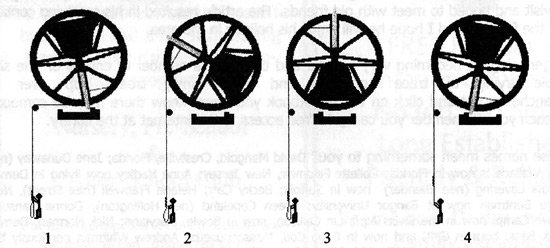The bells in Godmanchester Church are widely admired amongst experts, because they are well tuned and of a good size. The largest (always called the tenor") bell weighs (using the traditional units for bells) 19 hundredweights, 3 quarters and 20 pounds (1,013 kilogrammes) - eight pounds short of an old-fashioned ton - and is 44" (1.12 metres) in diameter. The smallest (always called the treble") is no trinket, weighing in at 6 hundredweights and 1 quarter (318 kilogrammes) and spanning a diameter of 31/2" (0.80 metre). These were all cast in 1794 by Thomas Osborn of Downham, except for number 6 (the higher the number the heavier the bell) which had to be re-cast in 1870 by Taylors of Loughborough. As is often the tradition, the 1794 bells were cast from the metal of a previous ring of Godmanchester bells. There were only five of these, but they were even heavier; the old tenor bell was about half as heavy again as the new tenor.
All the bells carry an inscription on them, the minimum being who made them and when. The treble has the additional "INTACTUM SILEO PERCUTE DULCE CANO" which is badly spelt Latin for Untouched I hang silent, strike me and I sing sweetly". On no. 4 there is "Our voices shall with joyful sound make hills and valleys echo round". The tenor has the names of the vicar, the bailiffs (predecessors of the Mayor) and the churchwardens in 1794.
That English Sound
When you hear bells ringing in Godmanchester, you are hearing a sound very particular to England (and I mean England, not Britain) and to a much lesser extent to those parts of the world with a very strong English influence. No wonder that film directors so often put church bells on their sound track to give the atmosphere of an English village. Two things distinguish the English way of ringing bells - they are rung full-circle" and they are rung musically.
Full Circle
"Full-circle" means that the bells are swung through a full 360 degrees, first one way and then the other:

- The ringer is about to pull down. Bell is in the "up" position.
- Rope starts to go up as the bell swings round (clockwise).
- Rope continues to go up. Bell is (briefly) in the "down” position.
- The bell has swung up with its own momentum and the ringer is about to pull again. This time it will go in the opposite direction (compare with 1).
With the bells weight, it is simply a matter of getting them started and letting the momentum do the rest. The clapper finally catches up with the bell and strikes it just before it reaches the top, so ringers hear the note at least a second after they have pulled the rope. The result is that, when ringing full circle, the clapper strikes harder and more cleanly than it would if the bells were not swinging quite as far. When ringers want to stop ringing they stand", or "set" their bells in the "up" position (see the diagram). However, we prefer not to leave them unattended in this position.
Listen to the Bells
As you walk to Church on a Sunday morning (or perhaps lie in bed, or set off for shopping), you can hear many different kinds of ringing from our church bells. Remember that we like to leave the bells in the down" position, so first we have to get them up again. Because of their weight, we do this by swinging them - further and further until they are eventually swinging the full circle. The ringing becomes slower, but louder as the angle the bells are swinging slowly increases to 360 degrees. This is done in a controlled manner, so that the bells always strike in the same order, starting with the smallest. The bells are stood in the "up" position ready for the next ringing.
Next, we usually ring call changes", but whatever sort of ringing we do, we always start and finish with rounds" - the bells striking in order from highest to lowest note. When a change is "called", an adjacent pair of bells in the sequence swap positions to produce a different tune. As more calls are made, the tune works gradually away from the original and then back again. As you listen, see if you can spot the changes. More complicated is method" ringing when the sequence is constantly changing and several pairs of bells are swapping places at once. About ten minutes before the service we start to ring the bells down - pretty much the opposite of ringing them up. Following this the tenor bell is chimed - swinging just enough to make the clapper strike it on one side; until about half a minute before the service when the treble is chimed (known as the call bell") and finally the clock strikes the time of the beginning of the Service.
If you're interested in doing this yourself, come to one of our practices at 7.30pm on a Wednesday night
CHARLES LOOKER